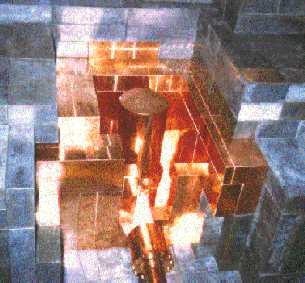| PHYSICS GOALS - (HDMS) |

"Direct Search for Dark Matter - Striking
the Balance - and the Future"
V. Bednyakov and H.V. Klapdor-Kleingrothaus

Weakly Interacting Massive Particles (WIMPs) are among the main candidates for the relic dark matter (DM). The idea of the direct DM detection relies on elastic spindependent (SD) and spin-independent (SI) interaction of WIMPs with target nuclei. In this review paper the relevant formulae for WIMP event rate calculations are collected. For estimations of the WIMP-proton and WIMP-neutron SD and SI cross sections the effective low-energy minimal supersymmetric standard model is used. The traditional one-coupling-dominance approach for evaluation of the exclusion curves is described. Further, the mixed spin-scalar coupling approach is discussed. It is demonstrated, taking the high-spin 76Ge dark matter experiment HDMS as an example, how one can drastically improve the sensitivity of the exclusion curves within the mixed spin-scalar coupling approach, as well as due to a new procedure of background subtraction from the measured spectrum. A general discussion on the information obtained from exclusion curves is given. The necessity of clear WIMP direct detection signatures for a solution of the dark matter problem, is pointed out.
"New constraints on spin-dependent WIMP-neutron interactions
from HDMS with natural Ge and Ge-73"
V. Bednyakov and H.V. Klapdor-Kleingrothaus and I.V. Krivosheina

In the mixed spin-scalar coupling approach the data from HDMS (Heidelberg Dark Matter Search) experiments performed in the years 1996, 1997, 2001-2003 both with natural Ge and with enriched 73Ge were simultaneously analyzed. This analysis together with a new procedure for background identification and subtraction from the measured 73Ge spectrum allowed us to obtain a significant (about one order of magnitude) improvement for the limits on the WIMP-neutron spin-dependent coupling. As a result, the HDMS experiment is now giving the most sensitive limits on the WIMP-neutron spin coupling for WIMP masses larger than 60–65 GeV/c.
"Status of HDMS and Potential of GENIUS Project"
V. Bednyakov and H.V. Klapdor-Kleingrothaus,
and
hep-ph/0011233
and in
Proc. of "DARK2000" - Springer (2001), and
hep-ph/9908427 and Phys. Rev. D 62:043524 (2000)
There is strong observational and theoretical evidence that dark, nonbaryonic matter accounts for about a third of the critical density of the Universe. Many candidates have been proposed and some of them (cosmions, heavy Dirac neutrinos) have already been rejected. Slow thermal relics born in an early phase of the Universe, stable or very long lived, are excellent candidates for nonbaryonic dark matter. These weakly interacting, massive (1 GeV - 1 TeV) particles (WIMPs) arise independently from cosmological considerations in supersymmetric models as neutralinos - the lightest supersymmetric particles. Direct detection of neutralinos can occur in very low background experiments, where the elastic neutralino scattering off target nuclei is exploited.
HDMS is a new Germanium experiment aiming to test the hypothesis that the dark halo of our Galaxy is made of WIMPs.
HDMS operates two ionization HPGe detectors in a unique configuration. A small, p-type Ge crystal is surrounded by a well-type Ge crystal, both being mounted into a common cryostat system. To shield leakage currents on the surfaces, a 1 mm thin insulator made from vespel is placed between them. Two effects are expected to reduce the background of the inner, WIMP target detector with respect to our best measurements of the HEIDELBERG-MOSCOW experiment. First, the anticoincidence between the two detectors acts as an effective suppression for multiple scattered photons, second, the detection crystal is surrounded by Ge, which is one of the radio-purest known materials. From previous measurements we know that the main radioactive background of Ge detectors comes from materials situated in the immediate vicinity of the crystals, i.e. from the copper parts of the cryostats.
HDMS has the goal to achieve the absolute background counting rate of 0.07 events per kg, day and keV in the region between 2 keV and 30 keV.
and thus to test the `evidence region' singled out by the DAMA experiment in the MSSM parameter space after about two years of measurement. It would be an independent test by using only raw data and a completely different detection technique.